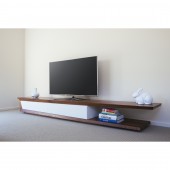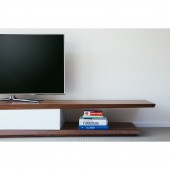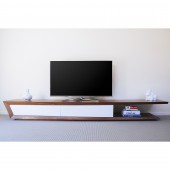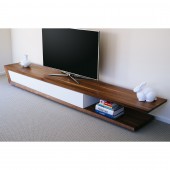
| THE AWARD |
| CATEGORIES |
| REGISTRATION |
| SUBMIT YOUR WORK |
| ENTRY INSTRUCTIONS |
| TERMS & CONDITIONS |
| PUBLICATIONS |
| DATES & FEES |
| METHODOLOGY |
| CONTACT |
| WINNERS |
| PRESS ROOM |
| GET INVOLVED |
| DESIGN PRIZE |
| DESIGN STORE |
| THE AWARD | JURY | CATEGORIES | REGISTRATION | PRESS | WINNERS | PUBLICATIONS | ENTRY INSTRUCTIONS |
Void Entertainment Unit by Cameron Ferry |
Home > Winners > Design #32607 >Interview |
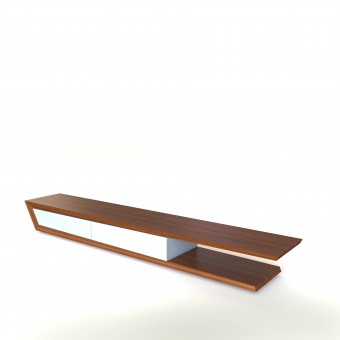 |
|
FS: What is the main principle, idea and inspiration behind your design?
CF: We wanted to create something different. The kind of entertainment unit that had never been seen before. Something that sparked conversation every time people encountered the entertainment unit.
FS: What has been your main focus in designing this work? Especially what did you want to achieve?
CF: I wanted to create something that I would enjoy interacting with for many many years. I wanted to create a piece of furniture that would eventually become something that was passed on to the next generation. That is why I have chosen the kinds of materials that I did, the construction processes and the lasting form of this contemporary design.
FS: What are your future plans for this award winning design?
CF: I honestly have none. I would be open to suggestion here. Right now it functions in our home as an entertainment unit, and I would be exceptionally happy if that was the only purpose this design ever served, it would still be a successful piece in my eyes.
FS: How long did it take you to design this particular concept?
CF: Design is a process, but the idea came in an instant. I figure that the fine detail took around about a day or so in total.
FS: Why did you design this particular concept? Was this design commissioned or did you decide to pursuit an inspiration?
CF: Originally I began this process to get our television off the floor. Purely out of necessity (if you can call and television and entertainment unit a real 'necessity'!)
FS: Is your design being produced or used by another company, or do you plan to sell or lease the production rights or do you intent to produce your work yourself?
CF: I think if the interest was there for it to go into production, I would certainly like the opportunity to product it myself, as I have wonderful and very talented contacts who would be ready to proceed. However, I would consider all options.
FS: What made you design this particular type of work?
CF: I have a passion for furniture design. Furniture, particularly bespoke furniture, is such a diverse and exciting form of design.
FS: Where there any other designs and/or designers that helped the influence the design of your work?
CF: The only inspiration I use was the daytime-running-lights of the Audi Q3. They have a very similar shape to the walnut time component of the piece that 'wraps' over the painted drawers.
FS: Who is the target customer for his design?
CF: I would probably suggest a high-end furniture collector. This would not be easy to mass produce for a mass market due to inefficiency in transportation and the labour costs of such a precise construction.
FS: What sets this design apart from other similar or resembling concepts?
CF: There is an exceptionally high level of detail that is not fully appreciated in any photographs. There are lots of subtile features that constantly intrigue and catch the eye. It is an exciting piece to interact with.
FS: How did you come up with the name for this design? What does it mean?
CF: Void is simply an acknowledgment of the lack of a third drawer. There is a negative, or empty space that is created by keeping one third of the total length open, without any drawer. It initially seems to upset the balance of the unit. However, it allows for the user to interact with the storage and display space more, because not only is the top surface available to display, but a lower level is also created.
FS: Which design tools did you use when you were working on this project?
CF: Much of the idea was actually developed as I drove, shortly after seeing the Audi Q3. So I would say the most utilised design tool was my imagination. I did sketch a quick image to communicate the idea to my wife, and then moved into CAD to develop and refine the design.
FS: What is the most unique aspect of your design?
CF: Its appearance. There simply isn't another entertainment unit this looks anything like it.
FS: Who did you collaborate with for this design? Did you work with people with technical / specialized skills?
CF: Thankfully the manufacturer, Alex Rains, is a brilliant and very talented wood worker. He was able to understand the design, interpret the details and respect the importance of even the more difficult aspects of the design to build.
FS: What is the role of technology in this particular design?
CF: The entertainment unit is a very low tech object in many respects. There are some rather fascinating feature that house technology that would not have been available in years gone by. That is not to say the unit couldn't have looked like it does, it simply would't have functioned in the same way. The push-to-open, soft-close draws runners for example are simple technologies that allow better usability.
FS: Is your design influenced by data or analytical research in any way? What kind of research did you conduct for making this design?
CF: No, there was no market research or any analytical research. As I mentioned, it was designed to serve a purpose in my own home.
FS: What are some of the challenges you faced during the design/realization of your concept?
CF: Difficulty finding a manufacturer who would construct the unit as detailed, and not want to make seemingly small and insignificant changes, that actually would have altered the final outcome to a point that compromise the design too much.
FS: How did you decide to submit your design to an international design competition?
CF: Well all the hard work was completed. The response for anyone who ever saw the unit was overwhelmingly positive and beyond my expectations. So I figured it would be fun to have a go and see how it would rate against a large and talented field of other designs.
FS: What did you learn or how did you improve yourself during the designing of this work?
CF: It really reenforced that one needs to be patient and not compromise. Continuing to strive for a better solution is always worthwhile.
FS: Any other things you would like to cover that have not been covered in these questions?
CF: No, thank you for your time.
FS: Thank you for providing us with this opportunity to interview you.
A' Design Award and Competitions grants rights to press members and bloggers to use parts of this interview. This interview is provided as it is; DesignPRWire and A' Design Award and Competitions cannot be held responsible for the answers given by participating designers.
| SOCIAL |
| + Add to Likes / Favorites | Send to My Email | Comment | View Press-Release |
